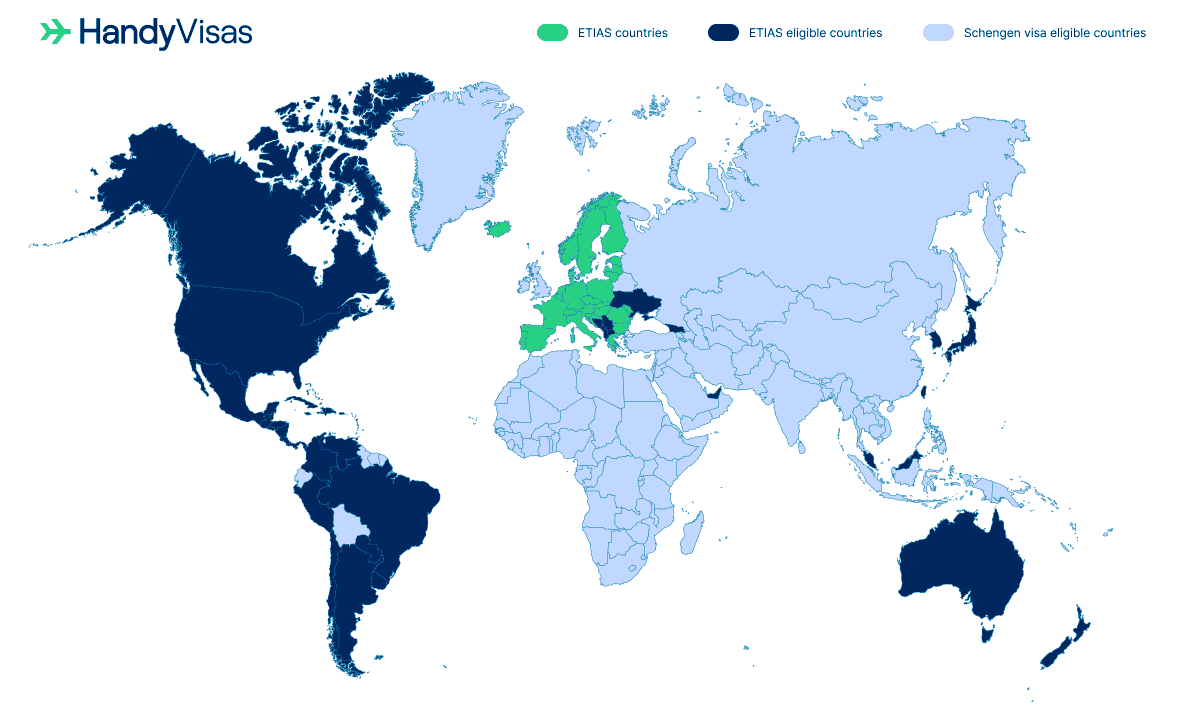ETIAS Visa Waiver

Information about the ETIAS Visa Waiver for Europe
ETIAS for Europe is a multiple entry travel authorization that allows holders to travel to Schengen countries for a total stay of 90 days per entry, for purposes of tourism, transit, business or medical treatment.
The European Commission is implementing the ETIAS visa waiver program for all nationalities who do not currently need a visa to travel to Europe. The aim behind the ETIAS travel permit is to strengthen and protect the borders of the Schengen passport-free zone.
The new system will prescreen visa-exempt travelers for any potential security or health risks before they even reach European borders. It is expected to come into effect in late 2026.
It is important to note that ETIAS is not a visa, but a travel authorization or visa waiver. It is not necessary to visit an embassy in order to apply. The ETIAS application form will be available online.
ETIAS is not a substitute for a student or work visa. Any foreign nationals who wish to live, study, work, or stay in Europe longer than 90 days will be required to apply for another visa from a diplomatic mission of their country of destination.
![]() Highlights
Highlights
ETIAS is expected to be launched in late 2026.
ETIAS is not a visa
All visa-exempt travelers need ETIAS
ETIAS application process - 100% online
ETIAS Countries
ETIAS will grant access to many European destinations when it launches in late 2026. This includes 25 EU countries and 4 non-European Union members: Iceland, Norway, Liechtenstein, and Switzerland.
Below you can find the list and a map that summarizes the ETIAS countries.
- Austria
- Belgium
- Czech Republic
- Denmark
- Estonia
- Finland
- France
- Germany
- Greece
- Hungary
- Iceland
- Italy
- Latvia
- Liechtenstein
- Lithuania
- Luxembourg
- Malta
- Netherlands
- Norway
- Poland
- Portugal
- Slovakia
- Slovenia
- Spain
- Sweden
- Switzerland
- Bulgaria
- Croatia
- Ireland (*)
- Republic of Cyprus (*)
- Romania
(*) ETIAS visa waiver expected to become a requirement for these countries in the future
The Schengen zone also includes the 3 microstates: Monaco, San Marino, and Vatican City, which maintain open or semi-open borders with other Schengen countries.
Croatia, Romania and Bulgaria have now been admitted to Schengen. As a result, air and sea border controls with other Schengen nations have been removed.
Although Cyprus is not yet part of Schengen, it is expected to use the ETIAS.
The Republic of Ireland opted out of the Schengen zone and maintains its own entry requirements.
Below you can find the list and a map that summarizes the ETIAS countries.
Countries that need ETIAS
Once the ETIAS system is implemented, all foreign citizens who are currently visa-exempt for Europe will be required to get the ETIAS visa waiver before traveling to the Schengen Area for short stays.
- Albania
- Antigua and Barbuda
- Argentina
- Australia
- Bahamas
- Barbados
- Bosnia and Herzegovina
- Brazil
- Brunei Darussalam
- Canada
- Chile
- Colombia
- Costa Rica
- Dominica
- El Salvador
- Federated States of Micronesia
- Georgia
- Grenada
- Guatemala
- Honduras
- Hong Kong
- Israel
- Japan
- Kiribati
- Kosovo
- Macau
- Macedonia
- Malaysia
- Marshall Islands
- Mauritius
- Mexico
- Moldova
- Montenegro
- New Zealand
- Nicaragua
- Palau
- Panama
- Paraguay
- Peru
- Saint Kitts and Nevis
- Saint Lucia
- Saint Vincent and the Grenadines
- Samoa
- Serbia
- Seychelles
- Singapore
- Solomon Islands
- South Korea
- Taiwan
- Timor Leste
- Tonga
- Trinidad and Tobago
- Tuvalu
- Ukraine
- United Arab Emirates
- United States
- Uruguay
- Vanuatu
- Venezuela
- United Kingdom

How to Apply for an ETIAS
The entire ETIAS application process will be done 100% online. There will be no need to visit any embassy or consulate belonging to a European country to deal with paperwork in person.
To apply for ETIAS, travelers will have to complete the following steps:
-
 Complete the ETIAS registration form using a device connected to the internet
Complete the ETIAS registration form using a device connected to the internet -
 Provide the required items, including basic personal details, contact details, passport information and questions relating to travel and security
Provide the required items, including basic personal details, contact details, passport information and questions relating to travel and security -
 Use a debit or credit card to cover the small ETIAS processing fee
Use a debit or credit card to cover the small ETIAS processing fee
ETIAS Application Process
The complete process of applying for and traveling with ETIAS is outlined below.
Frequently asked questions about the ETIAS
Schengen Visa Information
All non-visa-exempt citizens who are not eligible to apply for ETIAS will need to obtain a visa to travel to the Schengen Area. This applies no matter the duration or purpose of their stay.
The map above provides visual information about ETIAS eligible countries and Schengen visa countries.
Unlike ETIAS, which permits travel to all of the Schengen countries, a Schengen visa is typically issued for one individual European country.
In order to submit a Schengen visa application, it is necessary to visit the nearest embassy or consulate of the country the traveler wishes to visit.
There are several types of Schengen visas, depending on the purpose and duration of the intended stay in Europe. A Schengen visa may be issued as a single, double, or multiple-entry visa.
The Schengen visa application requirements state that the applicant must attend an embassy appointment with a range of supporting documentation.
This includes a valid passport containing at least 2 blank pages, travel insurance covering a stay within Schengen member states, and proof of sufficient financial means to cover the trip.
ETIAS-eligible citizens who wish to spend more than 90 consecutive days, or study, work, or live in Schengen countries, will also be required to apply for a Schengen visa corresponding to the duration and purpose of their intended stay.


